Cloud computing is no longer a trend; it's the backbone of modern business operations. As we move through the beginning of 2025, staying ahead of the curve requires understanding the key trends shaping the future of cloud computing.
Global IT spending will reach $5.74 trillion in 2025, according to Gartner. At the same time, businesses will spend $1.3 trillion on cloud solutions alone. However, when it comes to cloud computing trends, more spending is just the beginning.
This article looks at the five most important cloud computing trends to watch in 2025. It provides valuable insights into this dynamic landscape and highlights their potential impact on businesses. By understanding these emerging trends, businesses can leverage the power of cloud computing to drive innovation, optimize operations, and stay competitive in the digital age.
Let’s get started.
Cloud Computing Trend #1. The Intelligent Edge: AI-Driven Cloud and Edge Computing
AI and edge computing are converging to create a more intelligent and responsive cloud infrastructure. Let's explore how this powerful combination is reshaping the cloud landscape.
AI's Expanding Role in the Cloud
Artificial intelligence is becoming deeply embedded in cloud platforms, optimizing every facet of cloud operations and security.
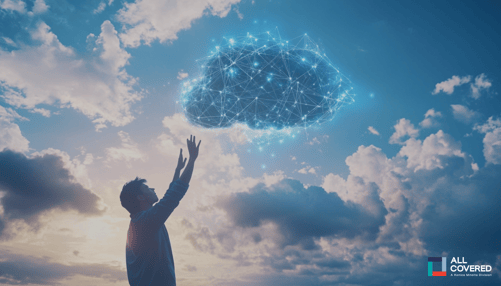
Cloud providers like Google Cloud and AWS are integrating AI and machine learning (ML) capabilities to offer intelligent services that automate complex tasks and enhance operational efficiency. This includes real-time resource allocation, automated scaling, predictive maintenance, and advanced security threat detection.
These advancements in cloud computing are crucial for businesses seeking to improve business processes and achieve enhanced efficiency.
Edge Computing and AI at the Edge
Edge computing extends the reach of the cloud to the edge of the network, enabling faster processing of data from IoT devices, autonomous vehicles, and other edge devices. AI in edge computing through on-device AI inference, on-the-edge AI model training, and thin-edge AI, was a key trend in 2024.
In 2025, we can expect increased adoption of edge computing, with AI workloads being deployed at the edge to enable faster decision-making and reduce reliance on cloud connectivity. This edge-to-cloud convergence will be crucial for applications that require real-time, low-latency data analysis, such as industrial automation processes critical for the manufacturing industry.
DeepSeek and the Future of AI in 2025
In 2025, Chinese AI startup DeepSeek emerged as a disruptive force in the field of large language models (LLMs). The company’s R1 model garnered attention for its impressive performance and cost-effectiveness.
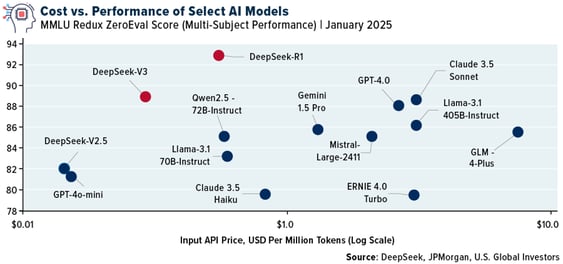
(Source: Forbes)
DeepSeek pulled this off by combining efficient design, innovative training techniques, and an open-source approach. This model has the potential to significantly reduce AI implementation costs across various industries and democratize access to powerful AI tools. So much so, that the release made NVIDIA shares drop in value by almost 16%, making the company lose hundreds of billions of dollars in just a few days.
As AI reasoning capabilities become more common and available thanks to developments like DeepSeek, we can expect more innovation and competition in the AI world. This could have possible effects on cloud computing and the use of cloud technologies.
Cloud Computing Trend #2. Hybrid and Multi-Cloud Strategies
Among businesses moving to the cloud, 76% of them use a hybrid or multi-cloud approach. But what exactly are they, and what benefits do they offer?
Definitions and Benefits
Hybrid cloud solutions combine on-premises data centers with public clouds. Multi-cloud strategies involve using services from multiple public cloud providers.
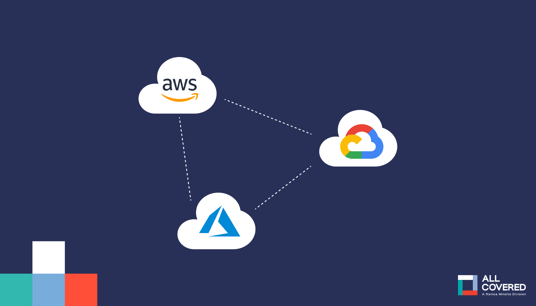
This blended approach offers several advantages, including:
- Increased flexibility
- Improved resilience
- The ability to avoid vendor lock-in
Organizations use hybrid or multi-cloud solutions to optimize workloads. They focus on choosing the best cloud environment for each specific task based on factors like cost, performance, and security requirements.
The Role of the Private Cloud
AWS continues to dominate the cloud infrastructure services market, controlling 30% of the market share. In fact, just three companies, AWS, Azure, and Google Cloud, control 63% of the market.
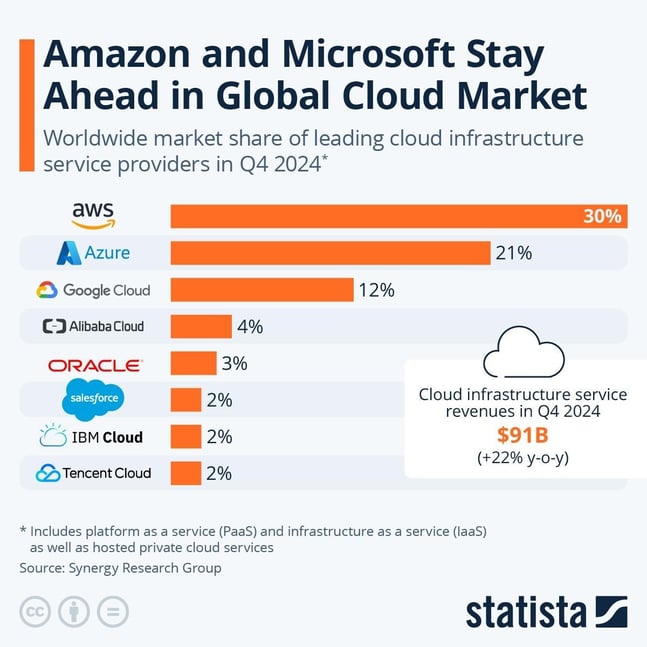
(Source: Statista)
Yet private clouds are gaining prominence, taking on a crucial role in hybrid and multi-cloud strategies. They offer enhanced security and control over sensitive data and applications. This improved security makes them ideal for organizations with strict compliance requirements or those seeking to maintain greater control over their IT infrastructure.
Businesses can integrate private clouds with public cloud services to create a hybrid environment that balances security, flexibility, and cost-efficiency.
Challenges and Optimization
Despite the advantages of multi-cloud and hybrid solutions, organizations face challenges in adopting these strategies. These include the need for security expertise, improved capabilities for cloud management, and guidance on cloud strategy. AI can play a crucial role in optimizing hybrid and multi-cloud deployments, enabling intelligent workload management and resource allocation across different cloud environments.
Cloud Computing Trend #3. Democratizing Development: Serverless and Low-Code/No-Code Solutions
Want to simplify application development in the cloud? Serverless computing and low-code/no-code solutions are here to help.
Serverless Computing and Its Advantages
Serverless computing allows businesses to build and deploy applications without managing servers. This approach offers several benefits, including scalability, cost-efficiency, and faster development.
This is becoming a strong cloud computing trend, with more than 70% of AWS users currently using one or more serverless solutions. This share has been rising steadily since 2022 for the three major cloud service providers.
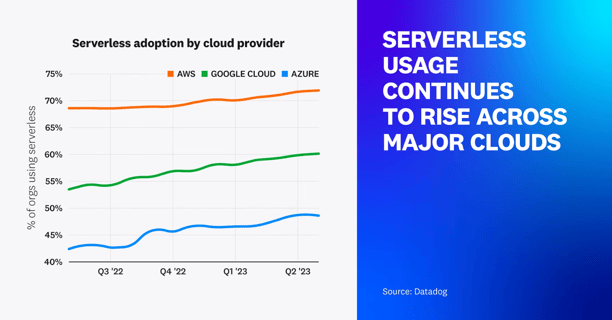
(Source: Datadog)
With serverless computing, businesses only pay for the computing resources they consume, reducing infrastructure costs and enabling cost optimization. Serverless platforms, such as AWS Lambda and Google Cloud Functions, provide a range of services that simplify the development process and enable faster application deployment.
Low-Code/No-Code Development and Citizen Developers
Low-code and no-code cloud solutions empower citizen developers—individuals with limited coding experience—to create applications with minimal or no coding.
These solutions provide visual interfaces and drag-and-drop tools that simplify the development process. They allow business users to create cloud applications tailored to their specific needs without the need for cloud software engineers.
This trend is accelerating application development and reducing the reliance on specialized developers, making it easier for businesses to adopt cloud-based solutions and develop cloud-native applications.
Cloud Computing Trend #4. Sustainable Cloud Practices
Energy consumption in data centers is no joke. They’ll consume around 536 terawatt-hours in 2025—2% of global electricity demand—and that number will grow by 14.7% annually. Consequently, sustainability is a growing concern in cloud computing, with companies like Microsoft, Google, Amazon, and Meta among the most sustainable data center companies in the world.
But it’s not just the big players. Data centers are going green across the board, with the green data center market size growing at a compound annual growth rate (CAGR) of 18.56%.
Let's look at how these and other cloud providers are reducing their environmental impact in 2025.
Environmental Initiatives
Cloud providers are increasingly investing in initiatives to reduce their environmental impact. This includes:
- Building energy-efficient data centers that utilize renewable energy sources.
- Implementing water conservation measures.
- Investing in carbon offset projects.
These initiatives are driven not only by growing environmental concerns, but also increasing regulations and the need to reduce operational costs.
Challenges and Opportunities
The increasing demand for cloud-based AI, with its huge amounts of data and need for computing resources, is intensifying the focus on energy-efficient data centers. Cloud providers are responding to this challenge by optimizing their infrastructure to reduce power consumption and improve energy efficiency.
Despite a growing focus on Water Usage Effectiveness (WUE) in data centers, water use is still a challenge. Large data centers consume 1 million to 5 million gallons of water per day—enough for 10,000–50,000 people.
With an ever-increasing demand for more cloud computing power, these numbers will only increase unless new cooling technologies are found.
Cloud Computing Trend #5. A Push for Innovative Cloud Security
The cloud security landscape is constantly evolving, with new and sophisticated threats emerging at an accelerated pace. Organizations must be proactive in their security posture, staying ahead of the curve to protect their valuable data and systems. This requires a shift towards more innovative and adaptive security solutions.
Evolving Threat Landscape
As cloud adoption continues to grow, so do concerns around cloud security. Organizations are facing an evolving landscape of threats and vulnerabilities in cloud environments.
Some of the most significant cloud security threats include misconfiguration, unauthorized access, and insecure interfaces.
The evolving cloud compliance landscape is also adding to the complexity of cloud security, with new compliance frameworks like the Network and Information Systems Directive 2 (NIS2) and the Digital Operational Resilience Act (DORA).
AI-Powered Security Solutions
AI is playing an increasingly crucial role in enhancing cloud security. AI-powered security solutions can analyze vast amounts of data to detect anomalies and potential threats in real time, enabling a proactive approach to security. These solutions can also help automate security incident response and improve the overall security posture of cloud deployments.
Confidential Computing
Finally, a more recent security technology for the cloud, called confidential cloud computing, is emerging. Confidential computing is a technology that uses hardware-based Trusted Execution Environments (TEEs) to isolate sensitive data and workloads during processing. This ensures that data remains secure even in untrusted environments like public clouds.
Summarizing the Future Trends in Cloud Computing
Let's recap the five key cloud computing trends we've covered and their potential impact on businesses.
|
Trend |
Impact |
|
AI-driven cloud and edge computing |
Increased efficiency, automation, and real-time processing capabilities. |
|
Hybrid and multi-cloud strategies |
Increased flexibility, resilience, and optimized workloads. |
|
Serverless and low-code/no-code solutions |
Accelerated application development and increased accessibility for citizen developers. |
|
Sustainable cloud practices |
Reduced environmental impact and improved resource utilization. |
|
AI-powered cloud security |
Enhanced security posture and proactive threat detection. |
Navigating the Cloud Frontier: What's Next?
The cloud computing landscape is evolving rapidly, with AI, edge computing, and sustainability playing key roles in shaping its future. By understanding and embracing these trends, businesses can unlock new opportunities for growth, efficiency, and innovation.
Organizations that adapt to these cloud computing trends and proactively address the associated challenges will be well-positioned to thrive in the digital age.
Thinking about making a move to the cloud? Download our Cloud Migration eBook and discover eight key questions to ask before beginning your transition.



